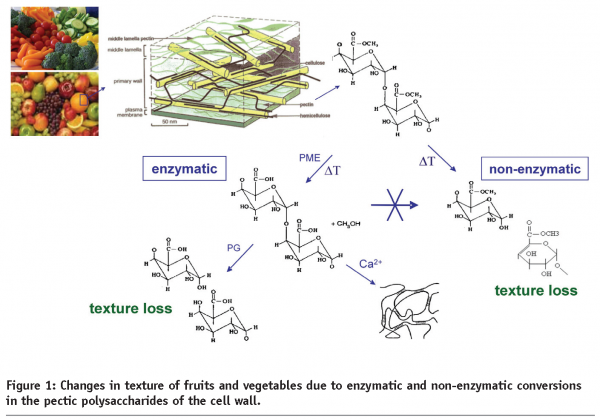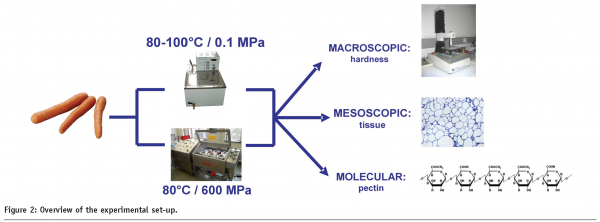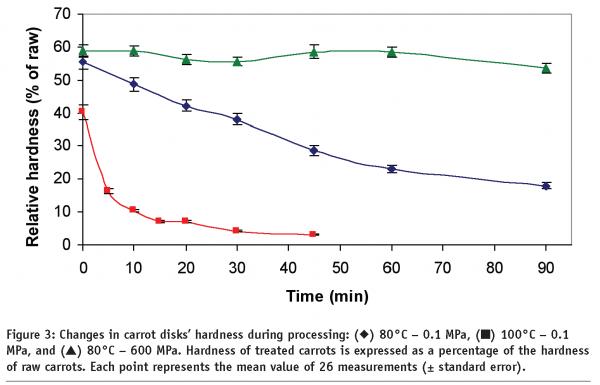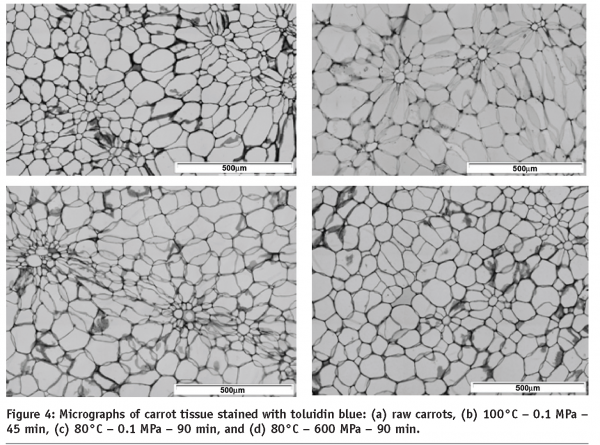Texture improvement under pressure: fantasy or reality?
Posted: 13 June 2008 | Ans De Roeck, Daniel Ndaka Sila, Thomas Duvetter, Marc Hendrickx and Ann Van Loey, Laboratory of Food Technology, Katholieke Universiteit Leuven, Belgium | No comments yet
Today, consumers are demanding high quality, fresh tasting foods free from additives, microbiologically safe and with an extended shelf-life. The most commonly used preservation method has been thermal processing, such as pasteurisation and sterilisation. However, these processes entail considerable organoleptic and nutritional quality losses. Food scientists and the food industry are therefore continuously searching for novel, less degradative processing technologies.
Today, consumers are demanding high quality, fresh tasting foods free from additives, microbiologically safe and with an extended shelf-life. The most commonly used preservation method has been thermal processing, such as pasteurisation and sterilisation. However, these processes entail considerable organoleptic and nutritional quality losses. Food scientists and the food industry are therefore continuously searching for novel, less degradative processing technologies.
Today, consumers are demanding high quality, fresh tasting foods free from additives, microbiologically safe and with an extended shelf-life. The most commonly used preservation method has been thermal processing, such as pasteurisation and sterilisation. However, these processes entail considerable organoleptic and nutritional quality losses. Food scientists and the food industry are therefore continuously searching for novel, less degradative processing technologies.
High pressure technology
High pressure technology has the potential to produce foods that meet many of the above-mentioned consumer demands1. High pressure processing uses pressures (in the range of 400-600 MPa / 0-50°C for pasteurisation and in the range of 500-800 MPa / 60-90°C for sterilisation) to inactivate enzymes and microorganisms. Pressure is transmitted uniformly and instantaneously throughout the food, which allows very homogeneous products to be obtained. At the same time, it offers advantages in minimal deleterious effects on food quality attributes, e.g. colour, flavour and nutritional value. Currently, high pressure processing is successfully applied on a commercial scale for pasteurisation of a whole range of food products. Given the technical progress made in high pressure equipment, commercial high pressure sterilisation is feasible in the near future. This process would involve both elevated pressure and elevated temperature contributing to sterilisation by inactivating spores and enzymes. Before commercial introduction, the influence of combined high pressure/high temperature processing on different quality attributes has to be investigated to evaluate whether it meets consumer demands.
Texture of fruits and vegetables
Texture is an important quality attribute of processed fruits and vegetables. Changes in texture during processing are closely related to enzymatic and non-enzymatic conversions in the pectic polysaccharides of the cell wall2 (Figure 1). Generally, pectin consists of a backbone in which galacturonan regions, with varying degrees of methylesterification, are interrupted by rhamnogalacturonan regions substituted by side chains rich in neutral sugars. Pectin plays an important role in intercellular adhesion and, consequently, in providing mechanical strength to plant tissues. Enzymatic degradation of pectin is catalyzed by the successive action of pectin methylesterase (PME) and polygalacturonase (PG). Initially, PME catalyzes the demethoxylation of pectin. Subsequently, the lowly methoxylated pectin is depolymerised by PG (if endogenously present). At elevated temperatures, highly methoxylated pectin is prone to non-enzymatic conversions: chemical demethoxylation and beta-elimination. The beta-eliminative depolymerisation is mainly responsible for the extensive (and mostly unwanted) softening of fruits and vegetables during heat treatments3. This depolymerisation leads to pectin solubilisation and, consequently, to decreased cell adhesion, resulting in tissue softening. The reaction rate is strongly dependent on the degree of methoxylation of pectin, pH and presence of ions. In order to improve or preserve the texture, limited demethoxylation is desirable because demethoxylated pectins are less susceptible to beta-elimination and can be ionically cross-linked by divalent cations such as calcium to form a gel-like network.
Case study
To explore the potentials of high pressure/high temperature (HP/HT) processing of plant tissue, the effect of combined HP/HT treatments on the texture of carrots was compared with that of high temperature (HT) treated samples4.
Carrot disks (~1 cm3) were on the one hand subjected to 80°C and 100°C in a water bath and on the other hand, 80°C in combination with 600 MPa in a multivessel high pressure equipment (Resato, Roden, The Netherlands). Subsequently, these carrots were investigated at macroscopic, mesoscopic and molecular level (Figure 2).
Macroscopic, the hardness of the processed carrots was evaluated by a compression test with a TA-XT2i Texture Analyzer (Stable Micro Systems, Surrey, U.K.) (Figure 3). In all cases, there was a rapid loss in the initial hardness due to membrane damage and turgor pressure loss. The hardness of the thermally treated carrots decreased further with increasing treatment time, probably due to beta-eliminative degradation of pectin. In contrast, the high pressure/high temperature treated carrots did not undergo further softening, indicating that the beta-elimination reaction of pectin is inhibited at combined high pressure/high temperature treatments.
Mesoscopic, the carrot tissue was examined with an Olympus BX-41 light microscope (Olympus, Optical Co. Ltd, Tokyo, Japan). Raw carrot tissue showed well defined, conspicuously well stained cell walls (Fig. 4a). The intensity of the cell wall staining decreased progressively with increasing thermal impact accompanied by increased cell wall thickening (Fig. 4b and 4c). These observations are probably due to heat induced solubilisation of the intercellular cementing pectin facilitating cell wall loosening. In contrast, high pressure/high temperature treated tissue showed close resemblance to the raw tissue, indicating that pectin solubilisation was limited (Fig. 4d).
At the molecular level, the degree of methyl esterification (DM) of the carrot pectin was determined. The DM of raw carrot pectin was estimated at 64%. For all the treatment conditions, the DM decreased. However, HP/HT treatment showed a more pronounced reduction. For example, after 45 min treatment, HT treated carrot pectin had a DM of approximately 50%, whereas HP/HT treated carrot pectin showed a DM of 31%. In case of thermal treatment, the decline may be explained by the occurrence of chemical demethoxylation of pectin at high temperatures. In case of the HP/HT treated samples, the high reduction may be explained by the combined effect of (a) chemical demethoxylation of pectin which is enhanced by pressurisation and (b) enzymatic demethoxylation of pectin due to enhanced pectin methylesterase activity within the study domain. To verify whether the low DM of pectin of the pressure/temperature treated carrots could indeed be linked to PME activity at those conditions; carrots were checked for residual PME activity. Raw carrots showed a PME activity of approximately 2679 U/kg. After 10 min treatment at 80°C/0.1 MPa, no residual PME activity could be detected. However, after 10 min at 80°C/600 MPa, residual PME activity (~398U/kg) was observed, even after 60 min (~19 U/kg). This could be related to the stabilising effect of pressure on PME. Consequently, the reduction in DM of HP/HT samples could (partly) be due to PME activity. As methyl esters are one of the main driving forces of the beta-elimination reaction, it is likely that the high reduction in DM of the HP/HT treated carrots triggered inhibition of the beta-elimination reaction, consequently preventing softening.
Conclusion
This case-study shows that the texture of carrots is better preserved in the case of combined high pressure/high temperature treatments as compared to high temperature treatments. Concerning the quality parameter texture, high pressure sterilisation offers an interesting alternative for heat sterilisation. However, more case studies, including other plant tissues (differing in pectin content, endogenous enzyme content, other texture related compounds) have to be carried out to generalise this statement. In the future, it will also be necessary to carry out sensory analysis of high pressure/high temperature treated plant tissues to evaluate the consumer response and appreciation. At the end, it is the consumer who will decide whether he buys the product or not.
Acknowledgement
This study has been carried out with financial support from the Commission of the European Communities, Framework 6, Priority 5 ‘Food Quality and Safety’, Integrated Project NovelQ FP6-CT-2006-015710.
“The authors of this article participate in the EC funded Integrated Project “NovelQ” that aims to remove hurdles to the application of novel food processing methods. For more information, visit www.novelq.org.”








References
- Ludikhuyze, L., Van Loey, A., Indrawati & Hendrickx, M. (2001). Combined high pressure thermal treatment of foods. In P. Richardson (Ed.), Thermal technologies in food processing (pp. 266-284). Cambridge: Woodhead Publishing Limited.
- Van Buren, J.P. (1979). The chemistry of texture in fruits and vegetables. Journal of Texture Studies, 10, 1-23.
- Sila, D.N., Smout, C., Elliot, F., Van Loey, A. & Hendrickx, M. (2006). Non-enzymatic depolymerisation of carrot pectin: Toward a better understanding of carrot texture during thermal processing. Journal of Food Science, 71(1), E1-E9.
- De Roeck, A., Sila, D.N., Duvetter, T., Van Loey, A. & Hendrickx, M. (2008). Effect of high pressure/high temperature processing on cell wall pectic substances in relation to firmness of carrot tissue. Food Chemistry, 107, 1225-1235.




